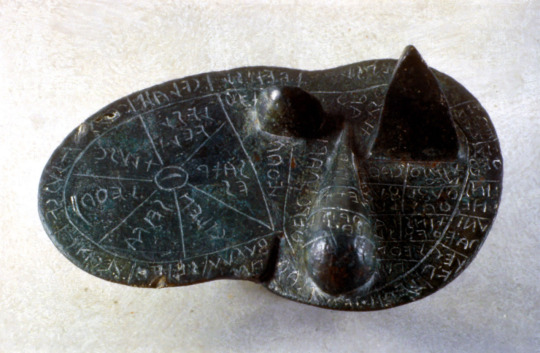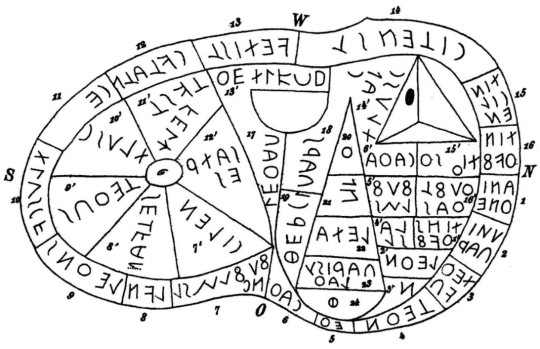#liver of piacenza
Explore tagged Tumblr posts
Text
Haruspex (pl. Haruspices)

Haruspices were Etruscan diviners who used the entrails of sacrificial animals to determine the will of the Gods. Very often they would examine the liver and gallbladder of a sheep. This life size bronze model is subdivided into sections and inscribed with the names of individual Etruscan deities. Last edit: 10/24/24 10:53am MT | Source 1 | Source 2 | Source 3 |
6 notes
·
View notes
Text


Liver of Piacenza, Etruscan, 2nd century BCE.
22 notes
·
View notes
Text

Liver of Piacenza, C200 BC
#Liver of Piacenza#liver#Piacenza#objects#divination#metaphysical#metaphysics#conjur#conjuring#trickery
5 notes
·
View notes
Text
It's Saturday, so time for a little Satre post! This deity is traditionally connected to Saturn. They appear on the Liver of Piacenza and are one of the nine aiser able to throw lightning. Saturn ended up being entirely Roman in origin! Yet, in my personal practice, I still connect Satre to Saturn - similar to the way I worship Eostre, despite her poor attestation in Anglo-Saxon myth & research. Satre does not have any artistic depictions. Yet through their connection to Saturn, I see Satre as a male deity. I haven't quite experienced/talked to/divined with him yet, but I plan to! I may do some divination today. Śin Satre!
#etrupol#etruscan polytheism#etruscan paganism#rasenna#etruscan#satre#liver of piacenza#aiser#ais#obscure deity
1 note
·
View note
Text
it's just me and my replica of the liver of piacenza against the world

154 notes
·
View notes
Text

Liver of Piacenza, bronze model of sheep's liver for the practice of haruspicy, Etruscan, 2nd C BC
140 notes
·
View notes
Text
Summanus (Latin: Summānus) was the god of nocturnal thunder in ancient Roman religion, as counterposed to Jupiter, the god of diurnal (daylight) thunder. His precise nature was unclear even to Ovid.
Pliny thought that he was of Etruscan origin, and one of the nine gods of thunder. Varro lists Summanus among gods to whom Sabine king Titus Tatius dedicated altars (arae) in consequence of a votum. Paulus Diaconus considers him a god of lightning.
In ancient Roman religion, the dii (also di) Novensiles or Novensides are collective deities of obscure significance found in inscriptions, prayer formulary, and both ancient and early-Christian literary texts.
Pliny mentions nine gods of the Etruscans who had the power of wielding thunderbolts, pointing toward Martianus's Novensiles as gods pertaining to the use of thunder and lightning (fulgura) as signs. Books on how to read lightning were one of the three main branches of the disciplina Etrusca, the body of Etruscan religious and divinatory teachings. Within the Etruscan discipline, Jupiter has the power to wield three types of admonitory lightning (manubiae) sent from three different celestial regions. The first of these, mild or "perforating" lightning, is a beneficial form meant to persuade or dissuade. The other two types are harmful or "crushing" lightning, for which Jupiter requires the approval of the Di Consentes, and completely destructive or "burning" lighting, which requires the approval of the di superiores et involuti (hidden gods of the "higher" sphere).
Several scholars have identified the Novensiles with the council of gods who decide on the use of the third, most destructive type of lightning. Carl Thulin proposed that two theonyms from the Piacenza Liver — a bronze model of a sheep's liver covered with Etruscan inscriptions pertaining to haruspicy — ought to be identified with the two councils, Cilens(l) with the Novensiles and Thufltha(s) with the Consentes Penates. The Novensiles would thus correspond to the di superiores et involuti and possibly the Favores Opertanei ("Secret Gods of Favor") referred to by Martianus Capella. Martianus, however, locates the Favores in the first region of the sky, with the Di Consentes and Penates, and the Novensiles in the second; the Favores are perhaps the Fata, "Fates".
10 notes
·
View notes
Text
Tivr, god of the moon

[ID: A photograph of the moon over a lilac purple sky, with small clouds to the near left and the bottom left of the image. To the bottom right is a cliff side, with another smaller cliff side behind the first. The moon is in a fingernail cresent.]
view this post on wordpress.
Tivr, Tiv, or Tiur, (Etruscan tiu/tiur, “month”) is the ais of the moon. They have been recognised as the moon ais as Tivr stands opposite to Usil on the Liver of Piacenza, on the “negative” side where the aiser of death and night reside. Converserly, Usil (at sunrise) and Tiv (at sunset) are separated on the liver from the sunset zone by the Suspensorium hepaticum (falciform ligament). As for syncretism, Tivr was likely identified with Luna and Selene akin to how Usil was identified with Helios and Sol.
Tivr’s symbol is the crescent, as witnessed in the heraldic symbol of the Tiuza family of Chiusi. Their tomb dates to the third-century within Tassinaia and is decorated with crescent moons, along with a shield marked with a lunar phase.
CATHA, GODDESS OF THE MOON?
Nancy de Grummond argues that Catha, the daughter of Usil, is a lunar goddess. Tiur’s name is mentioned in a dedicatory inscription on a bronze crescent to Catha reading “mi tiiurs kaθuniiasul.” The relationship between the two if we take Catha as a lunar goddess is unknown.
MODERN WORSHIP
Tivr is a deity with very little information. Many scholars identify Tivr as feminine due to Luna and Selene, however this may be untrue as no known depiction of Tivr exists. In modern worship we can worship Tivr as the god of the moon/month and let our experiences guide us in understanding this obscure ais.
References
de Grummond, N. T. (2004). For the Mother and for the Daughter: Some Thoughts on Dedications from Etruria and Praeneste. Hesperia Supplements, 33, 351–370. http://www.jstor.org/stable/1354077
Stevens, N. R. (2009). A new reconstruction of the Etruscan Heaven. American Journal of Archaeology, 113(2), 153–164. https://doi.org/10.3764/aja.113.2.153
The religion of the Etruscans. (2006). In University of Texas Press eBooks. https://doi.org/10.7560/706873
Turfa, J. M. (2012). Divining the Etruscan world: The Brontoscopic Calendar and Religious Practice. Cambridge University Press.
#dragonis.txt#tivr deity#rasenna polytheism#rasenna polytheist#etruscan polytheist#etruscan polytheism#etruscan paganism#rasenna paganism#aiser#paganism#pagan#witchblr#witchcraft
3 notes
·
View notes
Photo

The Etruscans were still using this kind of sheep liver based divination over 1,000 years later!
I can't remember the details, but apparently abnormalities in certain areas corresponded with flock killing diseases. So when organ readers, known as Haruspexs, predicted calamity, there was an actual factual basis for it.

Clay Object resembling a Sheep’s Liver. This is inscribed with magical formulæ; it was probably used for purposes of divination, and was employed by the priests of Babylon in their ceremonies.—Photo W.A. Mansell and Co
Myths & Legends of Babylonia & Assyria by Lewis Spence, 1916
- The Project Gutenberg
373 notes
·
View notes
Text




The Liver of Piacenza, a lifesize model of a sheep's liver used for haruspicy, the Etruscan practice of divination through the inspection of animals' entrails. Bronze, 2nd cen BCE.
210 notes
·
View notes
Photo

Bronze Liver of Piacenza
3 notes
·
View notes
Note

Trick or treat!
Harucispy manual
#the best haruspicy manual i know of#the piacenza liver#as long as you can read etruscan#images#shitposts
8 notes
·
View notes
Photo


Liver of Piacenza - bronze model of a sheep’s liver for the practice of Haruspicy - Etruscan - 2nd century BCE
In ancient Babylon the liver was considered the source of the blood and hence the basis of life itself. From this belief, the Babylonians thought they could discover the will of the gods by examining the livers of carefully selected sacrificial sheep. Haruspicy in ancient Italy originated with the Etruscans, but was incorporated into Roman culture. Roman haruspicy was a form of communication with the gods. This form of Roman divination allowed humans to discern the attitudes of the gods and react in a way that would maintain harmony between the human and divine worlds. This bronze model of a sheep's liver was found by chance by a farmer in 1877. Names of Etruscan gods are etched into the surface and organized into different sections.
1K notes
·
View notes
Text
two items in my etsy cart right now
plush of a clodsire in a hamburger bun
replica of the liver of piacenza
73 notes
·
View notes
Text




hello, again!!! 🖤
~another tiny update: (this tiny update got out of hand lol) anyway...... i am, and have been, working on getting everyone who expressed interest access to my references (in organized and annotated form), and other helpful resources on this topic of research!
mostly, i just wanted to say thank you again for the support and interest! i was just so blown away by everyone’s likes, messages, comments, and well-wishes... every paper i’ve turned in to my advisor has had a dumb, shameless pun in the title, and i’ve literally interned at the U.S. library of congress... but 0.000003% of tumblr’s attention focused on my paper is what gets me flustered 😭
(p.s. there's a little more info below the cut!)
so, i have decided to present the information from my research in a more accessible format... as a black first-gen immigrant community college-graduate with disabilities, who is finally about to graduate after like a decade of health stuff getting in the way of school, i’m really passionate about making sure everyone feels included in spaces like the one i’ve been trying to create using this blog... so, i mean, i could just share a long list of references… but slogging through dense academic sources can be really discouraging for some, and i’d love for as many people to get something out of this project as possible.
i envision (in approximate order of posting):
a fairly dry post of references with short annotations pointing to the useful sections + links that lead to the sources, with ideally nothing behind a paywall;
a second post covering my full paper and the main and supporting arguments, evidence, and of course, a controversies' section lol;
and i promise it won’t begin with “oookay tumblr,,, let me learn you a heckin’ thing!!!” :3
+ smaller occasional posts where i dive into a tangent i find interesting, or ~you~ find interesting and want additional information on... (have you been wondering something about my paper... or anything else? you can just ask me!)
also, in other good news, i’d like to share that I’ve been awarded a great slot in the conference i mentioned and will be presenting The Paper in, like, 10 days (!!!)
however, i am literally the embodiment of several mental illnesses and compulsive perfectionism in a trench coat pretending to be a perfectly functional, neurotypical human being, in her last semester of college... so please bear with me on timelines for the big posts.
tbh you can just ignore the photos up there... that’s just me messing around with formatting and completely abusing my newfound power of image background removal... EXCEPT!!! those are cool model livers for divination!!!: (1) Babylonian clay liver (2050-1750 BCE); (2) a liver model from Mari with the omen of siege (2000 BCE); (3) Liver of Piacenza (~100 BCE).
lastly (!) i would also love, if you’ve read this far, if you could let me know what has been your fave content from this space... i LOVE all the moodboards and the dark academia aesthetic posts, especially with minority representation (and will be making more myself when i have more time)… but i’m trying to make this space more interactive and bump up the academia in “dark academia”, rather than have it mainly be a space where i episodically resurface to reblog moodboards to thousands of people every few weeks.
but yeah! thank youuu again, especially if you read this far, and my inbox is always open!!!
- Sai 🖤
#black academia#black-academia#dark academia#academia#college#university#academic research#research#haruspex#haruspicy#economics#game theory#history#ancient greece#ancient babylon#mesopotamia
103 notes
·
View notes
